中国传统服饰色彩(英文版)
中国传统色彩CHINESE TRADITIONAL COLORS
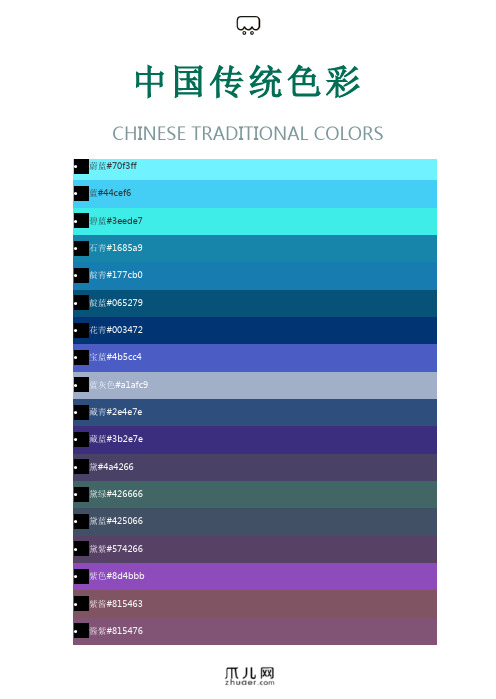
中国传统色彩CHINESE TRADITIONAL COLORS •蔚蓝#70f3ff•蓝#44cef6•碧蓝#3eede7•石青#1685a9•靛青#177cb0•靛蓝#065279•花青#003472•宝蓝#4b5cc4•蓝灰色#a1afc9•藏青#2e4e7e•藏蓝#3b2e7e•黛#4a4266•黛绿#426666•黛蓝#425066•黛紫#574266•紫色#8d4bbb•紫酱#815463•酱紫#815476•紫檀#4c221b •绀青#003371 •紫棠#56004f •青莲#801dae •群青#4c8dae •雪青#b0a4e3 •丁香色#cca4e3 •藕色#edd1d8 •藕荷色#e4c6d0 •朱砂#ff461f •火红#ff2d51 •朱膘#f36838 •妃色#ed5736 •洋红#ff4777 •品红#f00056 •粉红#ffb3a7 •桃红#f47983 •海棠红#db5a6b •樱桃色#c93756 •酡颜#f9906f •银红#f05654•石榴红#f20c00 •绛紫#8c4356 •绯红#c83c23 •胭脂#9d2933 •朱红#ff4c00 •丹#ff4e20 •彤#f35336 •酡红#dc3023 •炎#ff3300 •茜色#cb3a56 •绾#a98175 •檀#b36d61 •嫣红#ef7a82 •洋红#ff0097 •枣红#c32136 •殷红#be002f •赫赤#c91f37 •银朱#bf242a •赤#c3272b •胭脂#9d2933 •栗色#60281e•柳黄#c9dd22 •嫩绿#bddd22 •柳绿#afdd22 •葱黄#a3d900 •葱绿#9ed900 •豆绿#9ed048 •豆青#96ce54 •油绿#00bc12 •葱倩#0eb83a •葱青#0eb83a •青葱#0aa344 •石绿#16a951 •松柏绿#21a675 •松花绿#057748 •绿沈#0c8918 •绿色#00e500 •草绿#40de5a •青翠#00e079 •青色#00e09e •翡翠色#3de1ad•缥#7fecad •艾绿#a4e2c6 •石青#7bcfa6 •碧色#1bd1a5 •青碧#48c0a3 •铜绿#549688 •竹青#789262 •墨灰#758a99 •墨色#50616d •鸦青#424c50 •黯#41555d •樱草色#eaff56 •鹅黄#fff143 •鸭黄#faff72 •杏黄#ffa631 •橙黄#ffa400 •橙色#fa8c35 •杏红#ff8c31 •橘黄#ff8936 •橘红#ff7500•姜黄#ffc773 •雌黄#ffc64b •赤金#f2be45 •缃色#f0c239 •雄黄#e9bb1d •秋香色#d9b611 •金色#eacd76 •牙色#eedeb0 •枯黄#d3b17d •黄栌#e29c45 •乌金#a78e44 •昏黄#c89b40 •棕黄#ae7000 •琥珀#ca6924 •棕色#b25d25 •茶色#b35c44 •棕红#9b4400 •赭#9c5333 •驼色#a88462 •秋色#896c39 •棕绿#827100•棕黑#7c4b00 •赭色#955539 •赭石#845a33 •精白#ffffff•银白#e9e7ef •铅白#f0f0f4 •霜色#e9f1f6 •雪白#f0fcff •莹白#e3f9fd •月白#d6ecf0 •象牙白#fffbf0 •缟#f2ecde •鱼肚白#fcefe8 •白粉#fff2df •荼白#f3f9f1 •鸭卵青#e0eee8 •素#e0f0e9 •青白#c0ebd7 •蟹壳青#bbcdc5 •花白#c2ccd0 •老银#bacac6•苍色#75878a •水色#88ada6 •黝#6b6882 •乌色#725e82 •玄青#3d3b4f •乌黑#392f41 •黎#75664d •黧#5d513c •黝黑#665757 •缁色#493131 •煤黑#312520 •漆黑#161823 •黑色#000000。
中国传统服饰(英文)

Semi-formal dress
chang(裳):a pleated skirt bixi(蔽膝):long front cloth
panel attached from the waist belt. zhaoshan(罩衫):long open fronted coat
Formal dress
Xuanduan(玄端):a very formal dark robe, equivalent to the Western white tie
Shenyi(深衣):a long full -body garment
Curving-front robe(曲裾): diagonal body wrapping
Features
The general features of women's costume in Tang dynasty: • topless(上空装,袒胸装) • exposed arm • oblique collar • large sleeves • long skirt dress All of these make it deserve the most typical open clothing style.The clothing materials are exquisite,the structure is natural,graceful and elegant,and adornments are splendid.
Features
The Tang women dressed in sets of garments,and each set a unique in itself.
Features
中国传统服饰—汉服中英版
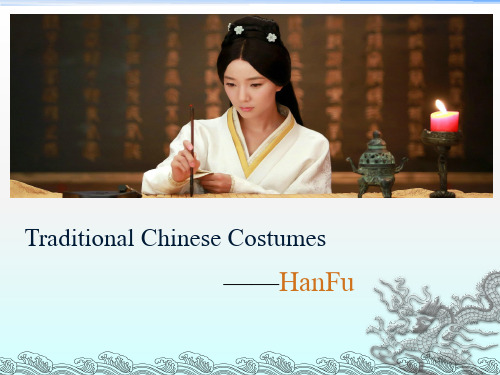
——HanFuIntroduc NhomakorabeaionChina's complete code of costume and trappings was established in the Han Dynasty. The yarning(纺纱), embroidering (绣花) and
Half-arm shawl 半臂
As the name suggests, half arm is half sleeve
Ru skirt 襦裙
Ru skirt belongs to a kind of hanfu,wear a short coat in the upside and a skirt in the downside. The top coat usually shorter than knee. It is the typically ‘top coat –plus-skirt ’ of clothing system.
曲裾相对于其他汉服很好分辨,曲裾的边 纹螺旋而下,螺旋到底的是曲裾,不到底 的是短曲裾。
Do you know which is the QuJu and the short QuJu?
Coat skirt
袄裙
Coat skirt is the dress that is outside the skirt .‘ao’, a jacket with a lining.
袄裙是指上衣在裙子之 外的女装,袄,是有衬 里的上衣。
Sleeved over-dress 褙子
Both sides from the armpit not sutured
中国传统服饰(英文)
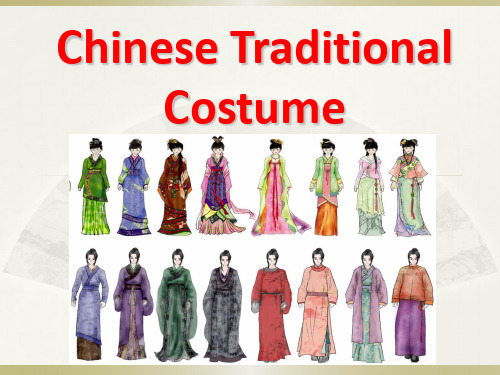
Features
The Tang women dressed in sets of garments,and each set a unique in itself.
Features
In general,the Tang women's dresses can be classified into three categories: The traditional ruqun(襦裙) or double layered or padded short jacket that is typical of central China.
Hanfu
Hanfu is known as Hanzhuang , is the traditional dress of the Han Chinese people. The term Hanfu derives from the Book of Han,which says,''then many came to the court to pay homage and were delighted at the clothing style of the Han.'' (后数来朝贺,乐汉衣服制度)
唐代文化是一种开放的类型,但宋代文化则 是一种相对收敛的类型,两者有很大的差异, 宋代在政治上虽然开放民主, 但由于“程 朱理学”的思想禁锢,和对外政策的妥协退 让,服饰文化不再艳丽奢华,而是简洁质朴。 宋代强调“存天理,灭人欲”的观念,使人 的个体对立性全部仰制了,对妇女的约束也 推到了极点,所以宋代女装拘谨、保守,色 彩淡雅恬静,宋代不论权贵的皇亲国戚,还 是一般的百姓,都爱穿着直领, 对襟的褙子, 因为既舒适得体,又显得典雅大方。
The_fashion_in_China中国服饰文化英文ppt
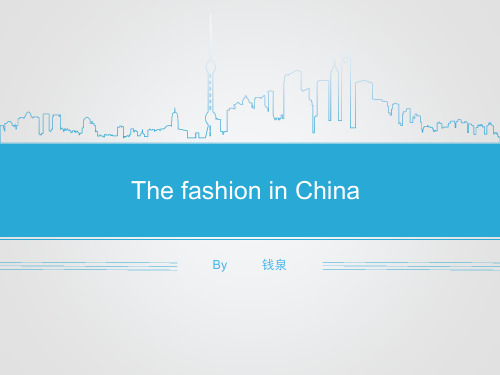
•WELCOME TO QING DYNASTY
Wide and loose Cover body A - line
Qing Chinese clothing
● shirt is not exposed
(衫不露外) ● the right-side lapel of junction decorated with buttons (偏襟右衽以盘纽为饰)
Why call Qipao china dress
Qipao, which is famous with its harmony and unity ,is known as the representative of the Chinese dress culture. It shows the elegant temperament of Chinese women, demonstrates the culture and virtues of our nation . It creates an impression of simplicity and quiet ,charm, elegance and neatness.
汉服穿衣示意图——中衣
Hanfu(汉服)has many patterns.Zhongyi(中衣)is usually worn inside,which like a shirt.Wearing in the house as pajamas,ually,it’s white or other plain colour.
short sleeves
sleeveless.
如意襟round Jin
琵琶襟Pipa Jin
斜襟 slanting Jin
中国古代服装英文介绍 ppt课件
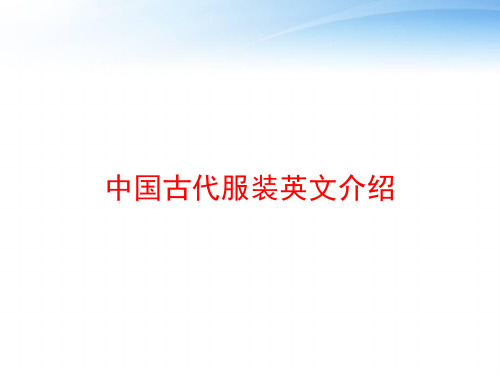
Hanfu(汉服)has many patterns.Zhongyi(中衣)is usually worn inside,which like a shirt.Wearing in the house as pajamas(睡衣),ually,it’s white or other plain colour.
中国古代服装英文介绍
Tang Dynasty
The dress style in Tang Dynasty is very open.Women’s dress and personal adornments (装饰)of the Tang Dynasty outstanding in China’s history.The clothing materials were exquisite(精致的,优美的),the structure (结构)was natural,graceful and elegant,and adornments were splendid.Though the forms of garments were still the continuation of the Han Dynasty and the Sui Dynasty,they were influenced by cultures and arts of the Wee古ch代e服s装t.英I文ns介id绍e the pants in the skirt. Foot
binding
Emperor
EmpressWedding
SlaveOfCfivicileiarn
中国传统服饰(英文)

The style of costume in Song Dynasty tended to be conservative, impressing people with simple, pure and elegant feelings. The main characteristics of women’s clothing are narrow, long, thin.
or jacket that is worn over the yi. Qun(裙) or chang(裳):Skirt for
women and men. Ku(裤):Trousers or pants.
Informal dress
Types include tops(yi) and bottoms (divided further into pants and skirts for both genders), and one-piece robes that wrap around the body once or several times)
Panlingpao(盤领袍):closed, round-collared robe; mostly used for official dress
Costume in Tang Dynasty
Contents
The brief introduction of costume in Tang Dynasty
中国古代服饰介绍英文 2
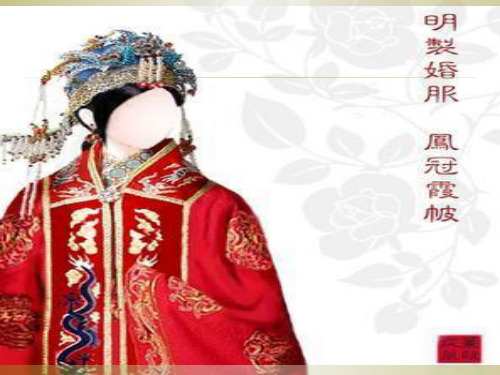
清朝汉族妇女服饰
清军入关后,清朝统治者强 制推行其满族的发型和服装样 式。这种民族压迫政策激起汉 族人民的强烈反抗。为缓和汉 族人民的反抗斗争,清朝不得 不实行“男从女不从”等十从 十不从的政策,即对汉族男子 严格要求遵从满族服制,而汉 族妇女服饰仍沿用明朝服装形 制。
Han Dynasty
Tang Dynasty
Qing Dynasty
周朝服饰
外衣也称礼衣,即朝服, 祭服,丧服等。 外衣皆直领,对襟,衽在左襟之上。衣衽 通常情况下 总是摺于衣内,而露出中衣, 这叫裼。如遇重大庄严场合,则合衽掩其 中衣,这叫袭。中衣衣领多以华美贵重之 物为之,且花纹图案绣于中衣之上,故常 裼露而显其美。之衣, 褶是表里皆用帛制 的双层上衣。夏天则穿细葛布或粗葛布做 的衣服
Bold 大胆
Colorful 绚丽多彩
Many styles 款式多样 Sexy 性感
Tang Dynasty
• from the sui to the tang, the ancient Chinese clothing developed to its peak, the political stability and economic development, manufacturing and textile technology, the frequent foreign relations, contributing to the the development of clothing . • 由隋入唐,中国古代服装发展到全盛时期,政治的 稳定,经济的发达,生产和纺织技术的进步,对外 交往的频繁等促使服饰空前繁荣,服装款式、色彩、 图案等都呈现出前所未有的崭新局面,而这一时期 的女子服饰,可谓中国服装中最为精彩的 篇章, 其冠服之丰美华丽,妆饰之奇异纷繁,都令人目不 暇接。
中国传统服饰(英文)

Song Dynasty
The clothing style of Song Dynasty is characterized by its elegance. Men usually wore gowns with round collars, while women wore short jackets or coats with matching short robes or Chinese-style jackets with buttons down the front. This elegant style was influenced by the dress of the northern minority peoples. Gauze pants. Southern Song dynasty .Chayuanshan, Fuzhou, Fujian province. This pair of pants is made from extremely thin gauze decorated with precious objects (gold ingots, swastikas, coral, rhinocerotic horns, dharma wheels), lozenges and flowers, all arranged in an elegant and orderly manner. Pants in this style were popular in the Song dynasty and usually worn under a long skirt.
The style of costume in Song Dynasty tended to be conservative, impressing people with simple, pure and elegant feelings. The main characteristics of women’s clothing are narrow, long, thin.
ThefashioninChina中国服饰文化英文
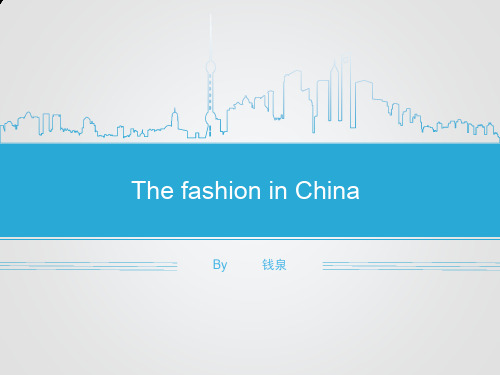
汉服穿衣示意图——中衣
Hanfu(汉服)has many patterns.Zhongyi(中衣)is usually worn inside,which like a shirt.Wearing in the house as pajamas,ually,it’s white or other plain colour.
men.
Tang Danysty
From the Sui to the Tang, the ancient Chinese clothing developed to its peak, the political stability and economic development, manufacturing and textile technology, the frequent foreign relations, contributing to the the development of clothing . Skirt,shirt, short embroidered cape (worn over a woman's shoulders)帔(披肩) the skirt seems very long. (唐代女装主要由裙、衫、帔组成。这时常将衫掩于裙内, 所以显得裙子很长。帔又名帔帛,像一条长而薄的披巾。)
waistband is above the chest .
Shenyi(深衣)is usually worn as a full dress(礼服),which we
can wear on Chinese holiday and some important ceremonies.If its edge is bent ,we can call it Quju(曲裾).If its edge is straight, it’s called Zhiju(直裾).And they can both worn by women and
The fashion in China中国服饰文化英文
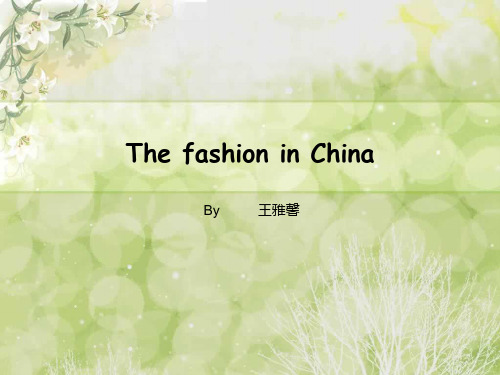
• Hanfu(汉服) is the traditional costume that has been worn by Han Chinese people for approximately 5000 years. It is believed to have been worn by the early leader of China, Huangdi(黄帝垂衣裳而 制天下).
衩
刺绣
襟
The style(样式)
• Chi-pao has many styles, and the change is mainly based on sleeves, Jin, collar, openings, and the length of Cheongsam.
long sleeves
• Qipao, which is famous with its harmony and unity ,is known as the representative of the Chinese dress culture. • It shows the elegant temperament of Chinese women, demonstrates the culture and virtuesof our nation . • It creates an impression of simplicity and quiet ,charm, elegance and neatness. . It’s a magnificent rainbow of the human culture.
WELCOME TO QING DYNASTY
Wide and loose Cover body A - line
中国传统元素 服装英语分享
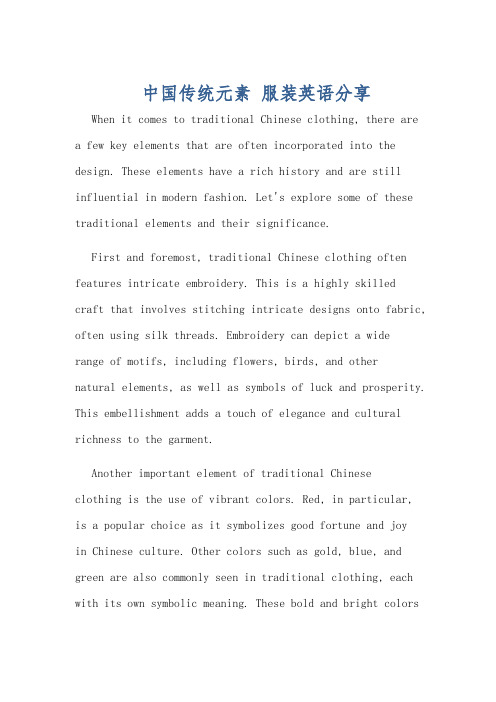
中国传统元素服装英语分享When it comes to traditional Chinese clothing, there are a few key elements that are often incorporated into the design. These elements have a rich history and are still influential in modern fashion. Let's explore some of these traditional elements and their significance.First and foremost, traditional Chinese clothing often features intricate embroidery. This is a highly skilledcraft that involves stitching intricate designs onto fabric, often using silk threads. Embroidery can depict a widerange of motifs, including flowers, birds, and othernatural elements, as well as symbols of luck and prosperity. This embellishment adds a touch of elegance and cultural richness to the garment.Another important element of traditional Chineseclothing is the use of vibrant colors. Red, in particular,is a popular choice as it symbolizes good fortune and joyin Chinese culture. Other colors such as gold, blue, and green are also commonly seen in traditional clothing, each with its own symbolic meaning. These bold and bright colorsmake traditional Chinese clothing visually stunning andfull of cultural significance.In addition to embroidery and vibrant colors,traditional Chinese clothing often features distinctive silhouettes and designs. For example, the cheongsam, also known as the qipao, is a form-fitting dress with a high collar and intricate button details. This style of dress has been popularized in both traditional and modern fashion and is recognized for its graceful and elegant appearance.Furthermore, traditional Chinese clothing often incorporates symbolic motifs and patterns. For instance, the dragon and phoenix are frequently used to represent power and prosperity, while the peony flower symbolizes beauty and grace. These motifs are often woven or printed onto fabric, adding layers of meaning and cultural significance to the garment.When it comes to accessories, traditional Chinese clothing is often paired with ornate hairpieces, jewelry, and footwear. Hairpins adorned with pearls and precious stones, jade bracelets, and embroidered shoes are just a few examples of the accessories that complement traditionalChinese attire. These accessories serve to enhance the overall aesthetic and showcase the attention to detail that is characteristic of traditional Chinese fashion.In summary, traditional Chinese clothing ischaracterized by intricate embroidery, vibrant colors, distinctive silhouettes, and symbolic motifs. Theseelements come together to create garments that are not only visually stunning but also rich in cultural significance. Whether worn for special occasions or incorporated into modern fashion, traditional Chinese clothing continues tobe a source of inspiration and admiration.说到中国传统服装,有一些关键元素经常被融入到设计中。
小学生英语作文中秋节的传统服饰(中英文翻译)
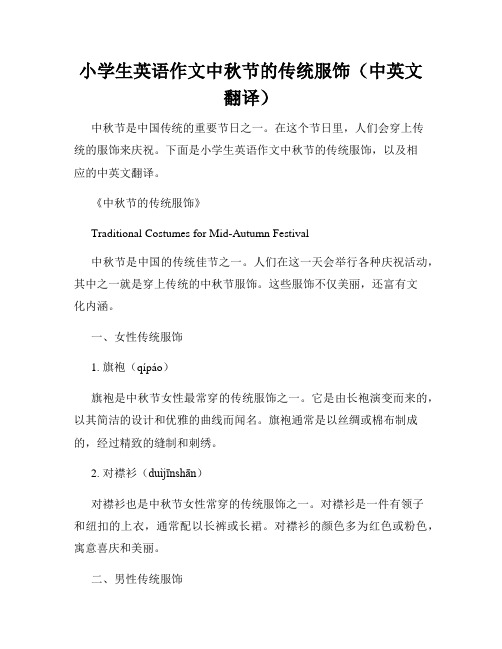
小学生英语作文中秋节的传统服饰(中英文翻译)中秋节是中国传统的重要节日之一。
在这个节日里,人们会穿上传统的服饰来庆祝。
下面是小学生英语作文中秋节的传统服饰,以及相应的中英文翻译。
《中秋节的传统服饰》Traditional Costumes for Mid-Autumn Festival中秋节是中国的传统佳节之一。
人们在这一天会举行各种庆祝活动,其中之一就是穿上传统的中秋节服饰。
这些服饰不仅美丽,还富有文化内涵。
一、女性传统服饰1. 旗袍(qípáo)旗袍是中秋节女性最常穿的传统服饰之一。
它是由长袍演变而来的,以其简洁的设计和优雅的曲线而闻名。
旗袍通常是以丝绸或棉布制成的,经过精致的缝制和刺绣。
2. 对襟衫(duìjīnshān)对襟衫也是中秋节女性常穿的传统服饰之一。
对襟衫是一件有领子和纽扣的上衣,通常配以长裤或长裙。
对襟衫的颜色多为红色或粉色,寓意喜庆和美丽。
二、男性传统服饰1. 唐装(tángzhuāng)唐装是中秋节男性常穿的传统服饰之一。
它是受古代唐朝服饰影响而设计的,以其简约大方而闻名。
唐装通常由长袍、长裤和对襟上衣组成,颜色多为深蓝或黑色。
2. 长袍(chángpáo)长袍也是中秋节男性常穿的传统服饰之一。
长袍是中国古代的传统服饰,通常是由丝绸制成的。
长袍的设计非常简单,但给人一种庄重和典雅的感觉。
三、中英文翻译1. 旗袍(Qípáo)- Qipao2. 对襟衫(Duìjīnshān)- Chinese Button Shirt3. 唐装(Tángzhuāng)- Tang Suit4. 长袍(Chángpáo)- Changpao这些传统服饰在中秋节期间被广泛穿着,不仅增添了节日的喜庆氛围,还展示了中国的优秀传统文化。
通过穿上这些服饰,人们可以更好地感受到传统与现代的结合,传承与创新的融合。
中国古代服饰介绍英文
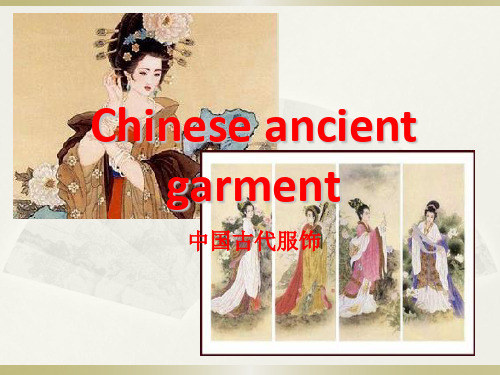
Tang Chinese clothing
●bold 大胆的 ●colorful 多彩的 ●various styles 样式繁多
清朝
在清朝,服饰都是雍容 华贵的。根据清政府 规定,人们那时穿的 衣服应该适合他们的 社会地位,官位阶级和 生活方式。因为满族 是清代少数的力量,清 朝的服装展现了一个 明显的游牧民族的特 征。
Qing Chinese clothing
●Rectangular outline (外轮廓呈长方形) ● clothes do not get the waist down (衣服上下不取腰身) ● Horseshoe-shaped sleeve cover hand (马蹄袖盖手)
● set rolling craft decoration (镶滚工艺装饰)
Qing Chinese clothing
● shirt is not exposed (衫不露外) ● the right-side lapel of junction decorated with buttons (偏襟右衽以盘纽为饰) ● clothing plus clothing (衣外加衣) ● increase waistcoat or jacket (增加坎肩或马褂)
Han Chinese clothing
● bugle-shaped lap(喇叭状 下摆) ● cross collar style (usually overlap the right collar to the left one交领右衽)
● hide the band and the buttons(隐扣束带)
Chinese ancient garment
中国古代服饰
阅读材料:中国传统服饰英文简介
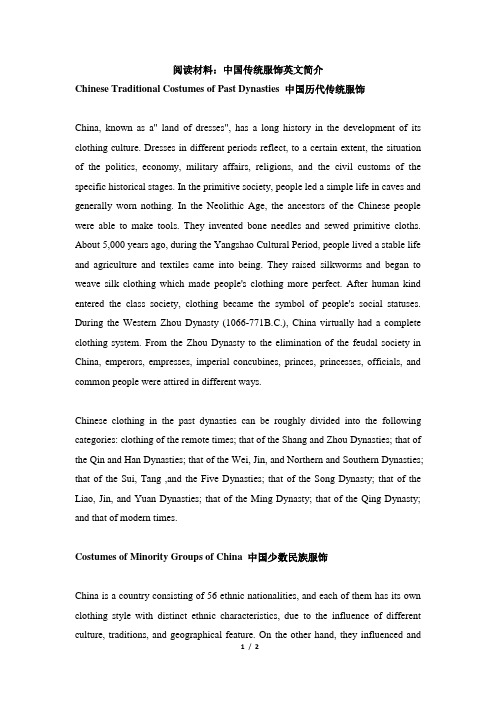
阅读材料:中国传统服饰英文简介Chinese Traditional Costumes of Past Dynasties 中国历代传统服饰China, known as a" land of dresses", has a long history in the development of its clothing culture. Dresses in different periods reflect, to a certain extent, the situation of the politics, economy, military affairs, religions, and the civil customs of the specific historical stages. In the primitive society, people led a simple life in caves and generally worn nothing. In the Neolithic Age, the ancestors of the Chinese people were able to make tools. They invented bone needles and sewed primitive cloths. About 5,000 years ago, during the Yangshao Cultural Period, people lived a stable life and agriculture and textiles came into being. They raised silkworms and began to weave silk clothing which made people's clothing more perfect. After human kind entered the class society, clothing became the symbol of people's social statuses. During the Western Zhou Dynasty (1066-771B.C.), China virtually had a complete clothing system. From the Zhou Dynasty to the elimination of the feudal society in China, emperors, empresses, imperial concubines, princes, princesses, officials, and common people were attired in different ways.Chinese clothing in the past dynasties can be roughly divided into the following categories: clothing of the remote times; that of the Shang and Zhou Dynasties; that of the Qin and Han Dynasties; that of the Wei, Jin, and Northern and Southern Dynasties; that of the Sui, Tang ,and the Five Dynasties; that of the Song Dynasty; that of the Liao, Jin, and Yuan Dynasties; that of the Ming Dynasty; that of the Qing Dynasty; and that of modern times.Costumes of Minority Groups of China 中国少数民族服饰China is a country consisting of 56 ethnic nationalities, and each of them has its own clothing style with distinct ethnic characteristics, due to the influence of different culture, traditions, and geographical feature. On the other hand, they influenced andlearned from one another in the way they dresses themselves as people of various ethnic lived together or migrate.As a result, the dresses of various ethic groups, like their culture, share something in common while they have their own ethnic, regional, and traditional features as well as traces of merge and transformation, forming a brilliant feature, colorful clothing culture of the Chinese. Roughly speaking, the loose gown and long robe worn by the people of the minority tribes in northern China are straightforward and the long skirt and pants worn by the people in southern China are made of fine workmanship. Due to the impact of the complicated geography and climate, the clothing of the minority nationalities in southern China is richer in variety and more colorful than that of the minority groups in the north. Dresses are the important symbols of the ethnic nationality identification and the blood lineage of China's minority groups. People usually are attired in special way on such occasions as festivals, wedding, religious, and funeral ceremonies, and other important activities. The change of clothing manifests an ethnic group's economic life, religious belief, world outlook, ideology, aesthetic consciousness, customs, and its course of development.Chinese Qipao Dress (Cheongsam) 旗袍中山装The Qipao dress dates back to the Ming and Qing Dynasties. Perfectly fitting the beautiful figure of Asia females, it is regarded as quintessence of China, reflecting the Chinese culture and arts. While the Qipao makes people's life more colorful with its national characteristics and strong happy colors and fashion designs, it possesses a lasting value itself.。
